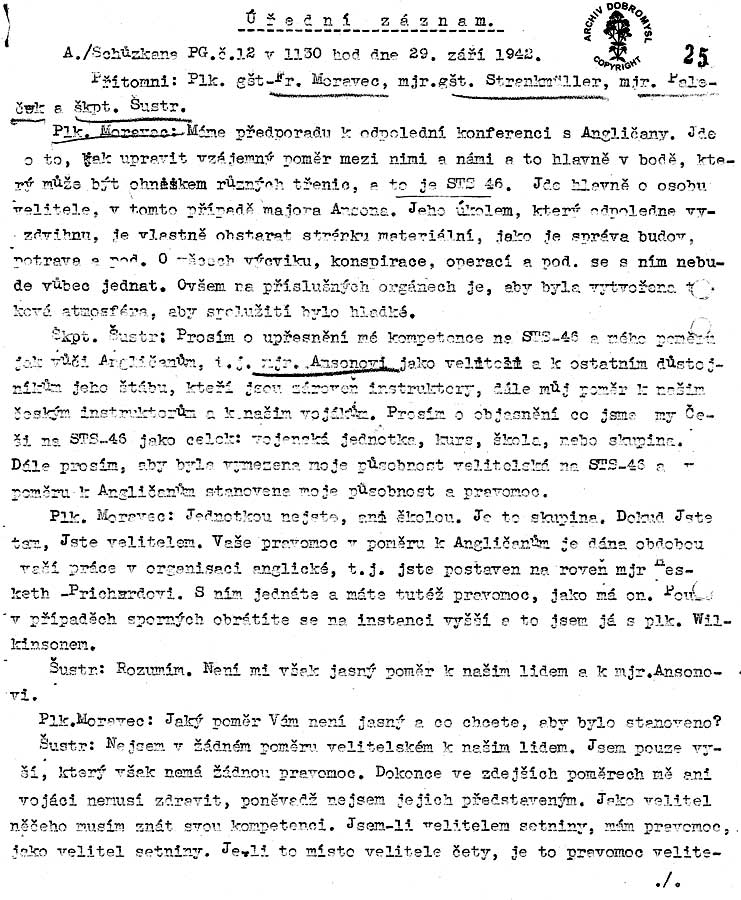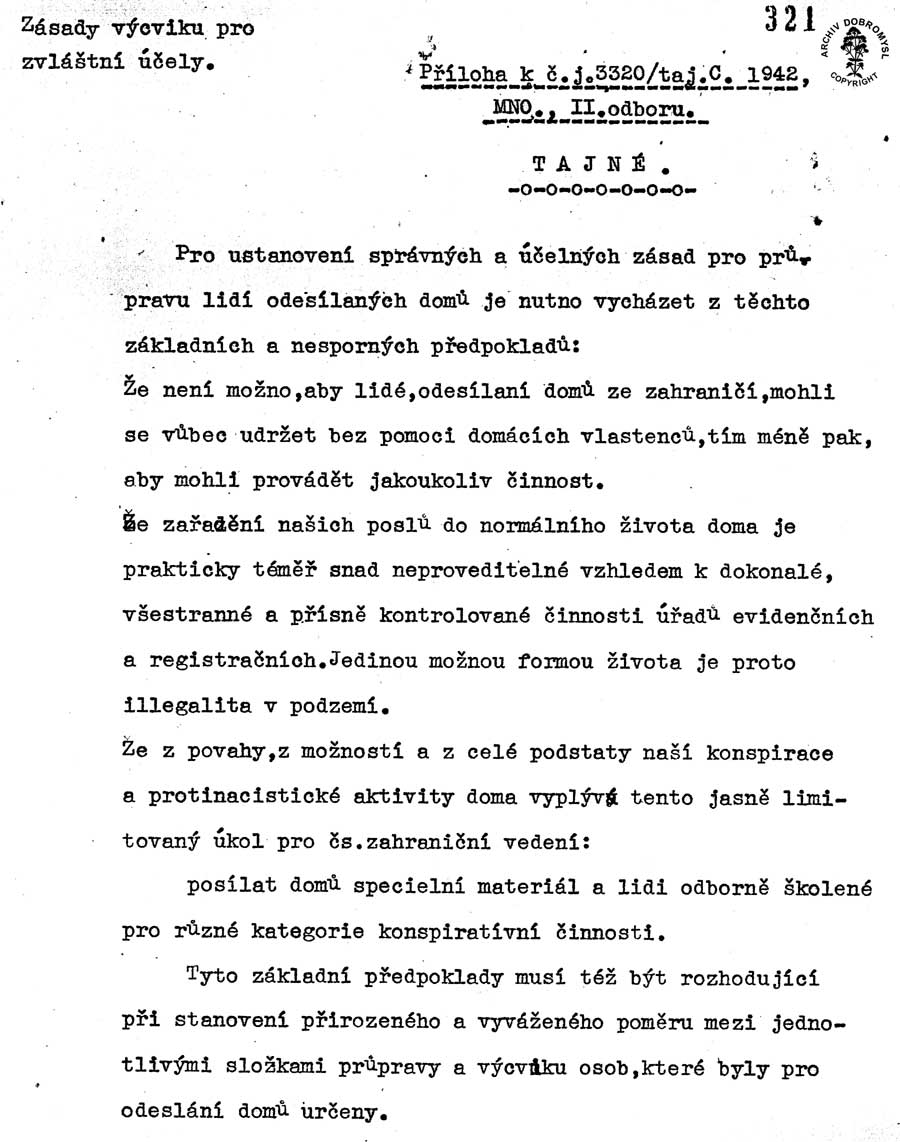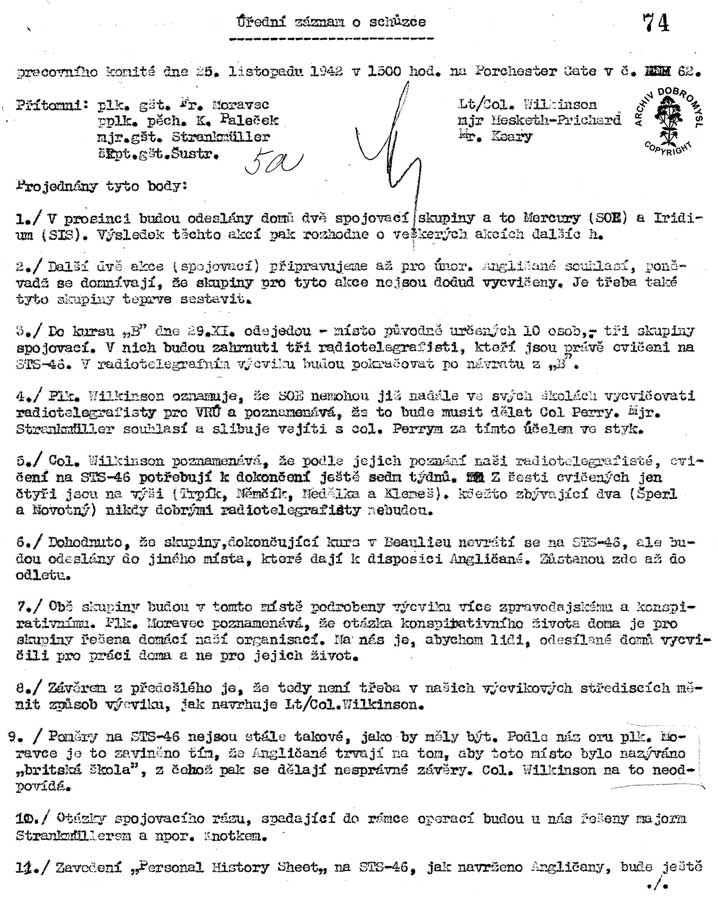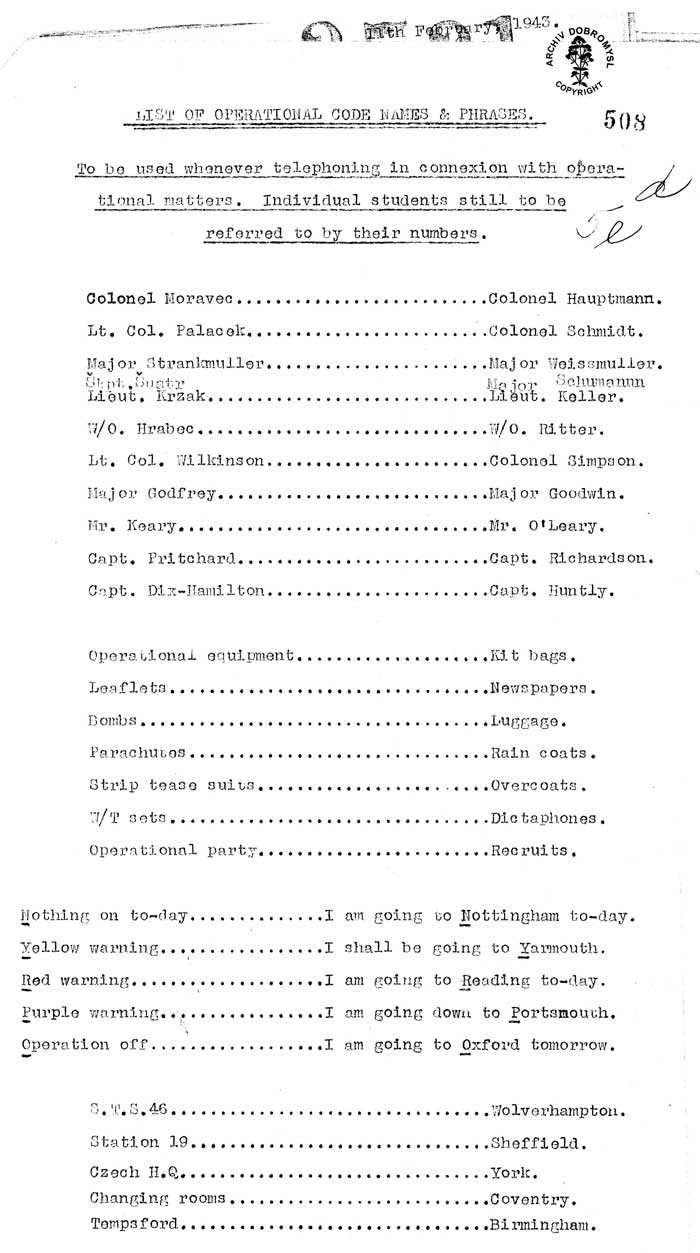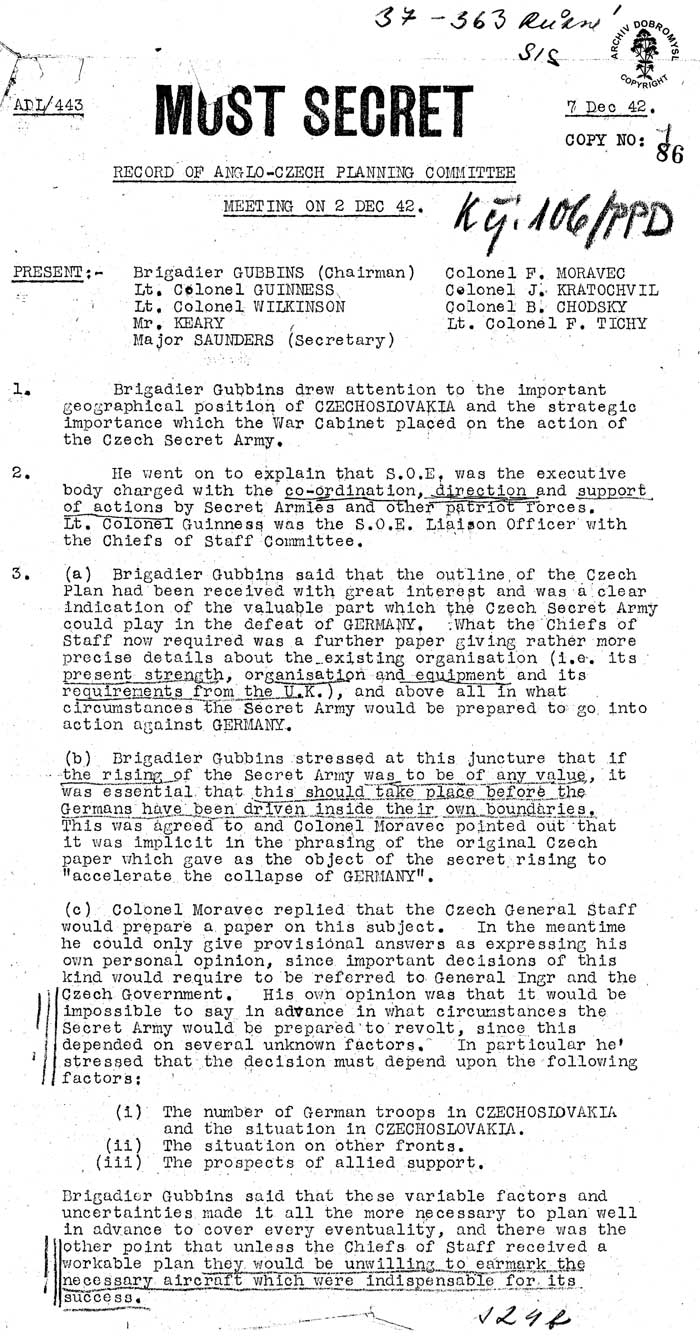|
Part 2: Cooperation between SOE and Czechoslovak Military Intelligence Officers A brief notice board dealing with the origins of SOE; the transfer of Czechoslovak Military Intellligence Officers to Britain and their mutual co-operation
The Czechoslovak Military Intelligence Service – the 2nd. Department of the General Staff of the Ministry of National Defence (MND) – had co-operated with British Secret Intelligence Service from the middle of the 1930s. After the Anschluss of Austria, despite official British policy, it gained strength. Having gleaned much information about the upcoming occupation of the rest of Czechoslovakia, the growing unrest in Slovakia and intelligence from Agent A 54 (Paul Thümmel) about the planned occupation from 11th March 1939, the Czechoslovak side informed Major Gibson, the SIS representative in Prague. He, almost immediately, passed this information back home and was instructed to offer the Czechoslovaks the transfer of a certain number of people to the United Kingdom. Eleven Czechoslovak intelligence officers, headed by Colonel František Moravec of the General Staff were flown to Great Britain on board a KLM plane, which landed at London’s civil airport Croydon at 22.40 on 14th March, 1939. Indeed, this was just a few hours before the occupation of the rump of Bohemia and Moravia by German armed forces. The group of eleven Czechoslovak intelligence officers, who arrived with František Moravec, is usually referred to as “Moravec’s XI”. The Czechoslovak Military Intelligence Service was the first among emigrant services of the occupied countries, which gradually settled down in London and it kept its unique status until the end of the war. In terms of the agreement with SIS, mutual co-operation between both organisations consisted of the exchange of information. Undoubtedly, the most fruitful period was between 1941 and 1942. From the autumn of 1942 the importance of Czechoslovak intelligence officers began to decline with the growth of a diversity of intelligence resources. A change in the status of Czechoslovak intelligence officers in Great Britain occurred on 21st July, 1940, when HM Government recognized the Provisional Czechoslovak Government-in-Exile, with President Beneš as its head. The Czechoslovak exile authorities, established in the summer of 1940, also comprised the newly established Ministry of National Defence (MND), headed by General Sergej Ingr. It also had the now officially re-grouped 2nd Department – Intelligence. The post of chief of the 2nd Division was given to Colonel Moravec. The official HQ of the 2nd Department was at the Czechoslovak Ministry of National Defence, 131 Piccadilly, but Colonel Moravec formed the real centre in Porchester Gate on Bayswater Road in London. Between the years 1941-1945 the 2nd Department was internally divided into three main sections: 1st Section of Offensive Intelligence, 2nd Section of Defensive Intelligence and the Military Radio Section. The most important Section in terms of the preparation and training of Czechoslovak parachutists was the 1st Section under the command of Major Emil Strankmüller. Between 1941 and 1945 the 1st Section was subdivided into: Intelligence Group (A), Study Group (B), Cipher Group (C), and Special Group (D). Intelligence Group A directed spying activities against Germany, relying upon the live spy network of Czechoslovak Military Intelligence. It maintained contacts with the Allies and passed intelligence to them. Study Group B gathered intelligence from Group A; assessed it and formulated it into comprehensive intelligence reports, analyses and studies of the enemy. Cipher Group C decoded messages from Military Radio Section and, conversely, encoded messages to be sent from Military Radio Section. The summer of 1940 brought many changes. One of them was the founding of SOE. SOE activities, in terms of its plans and the concept, also potentially included the support of a resistance movement in the Protectorate, which could become one of the efficient instruments of war against Germany. The activities of the Czechoslovak Military Intelligence thus gained a different perspective. For SOE, the new organization represented the possibility of placing its own people into the Protectorate and influencing the local situation, as well as being well informed about it. After the establishment of SOE and initial contacts with it, the Czechoslovak intelligence officers founded a special department responsible for the training of men for special operations – Special Group D. This Group was subdivided into three Sections: Command, Training and Support. The Command Section was responsible for the selection of suitable candidates for training; the organizational provision of training in cooperation with British authorities; administration; the targeted training of individuals according to their potential missions, the assessment of preparation and the processing of data for organizational use. Two men who were at the top of the Command Section during World War II were Captain Jaroslav Šustr and Major Karel Paleček. The second section of Special Group D was the Training Section, responsible for the fulfilment of the programme of training for Czechoslovak parachutists. The officers of this Section, together with selected personnel, took part in training run by the British, and they themselves organized day-to-day and enhanced training in the buildings allocated to SOE for the training of Czechoslovak parachutists, called Special Training Schools (STS). SOE – Special Operations Executive – was founded at a time when Great Britain was the only active enemy of Hitler on the Continent, in the summer of 1940. Its main task was irregular warfare and the Prime Minister Winston Churchill charged it with setting Europe ablaze, so that the Nazi regime would be destroyed from inside. The main idea of irregular warfare was to use any method available to undermine the enemy’s strength. Amongst the types of irregular fighting was a whole spectrum of activities – partisan warfare, sabotage, espionage, the formation of resistance movements, assassinations, and all these were to take place directly in the enemy’s backyard. After a certain amount of rivalry,” SOE became part of the Ministry of Economic Warfare, led by Hugh Dalton. The official date of its foundation is said to be 22nd July 1940, when the War Office considered its charter. The existence of SOE was a strict secret; it was part of the Prime Minister’s competence and it was never to be discussed on the floor of the House of Commons, nor anywhere else. Ordinary employees of the Ministry of Economic Warfare were to be kept in the dark about its existence, though it was ultimately responsible to their own Minister. SOE operated until the end of 1945, when the new Prime Minister Clement Atlee decided that it was no longer needed in peacetime. Three men were in charge of SOE in turn: Sir Frank Nelson, in connection with the Minister of Economic Warfare, Hugh Dalton; Sir Charles Hambro and Colin McVean Gubbins, executive directors under the Minister Lord Selborne. Especially Gubbins, who was appointed its chief between 1943 to 1945, became SOE’s most prominent figurehead. From an inconspicuous site at 64 Baker Street, London, the organisation grew into a wide-ranging colossus. During the period of its greatest activity, at the time of preparation for the invasion of France, it employed about 13 000 men and women. Its structure comprised a complex system of sections, which could be divided into two parts. The first part consisted of sections, which were tasked with the material preparation and support of operations. The second part comprised sections, which focused on operations themselves. The operational section consisted of a complex system of national sections and regional HQs spread throughout theatres of war. SOE formed its own Czech Section, called MY, for operations in the Protectorate in the summer of 1940-41. It had its HQ at Norgeby House, Baker Street. Towards the end of 1940, Peter Wilkinson was put in charge of co-ordinating operations with the Czechoslovaks. He had worked in Prague before the war as an intelligence co-ordinator at the War Office, under cover as an immigration official. During the reorganization of SOE in November 1941, Peter Wilkinson was charged with the overseeing of German and Austrian programmes, in addition to supervising the Poles and Czechs. He, therefore, appointed Alfgar Hesketh-Prichard as the Czech Section chief. In 1943, both of them were replaced. Thus, Francis Edward Keary became the longest serving ally of the Czechoslovaks. Like Wilkinson, he had worked as an intelligence officer in Czechoslovakia before the war, under cover as a private English tutor and spoke Czech very fluently. In January 1943 he took command of the entire Czech Section. In April 1944 Keary went to Italy with other Czechoslovaks and he was replaced in his London post by Peter W. Auster, who remained in position as liaison officer with the 2nd Department until the end of the war. In 1943, a regional Central European Section was formed within SOE. H.B. Perkins was appointed as its head. The Central European Section was responsible for activities of SOE in Czechoslovakia, Poland and Hungary. |
HOME PAGE
Dokument No.1
|
















